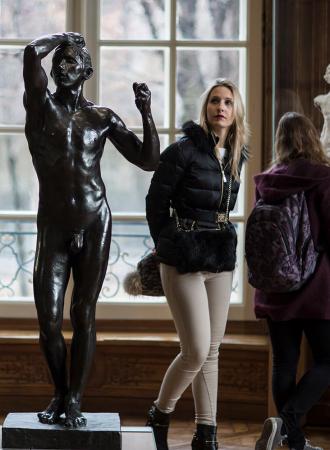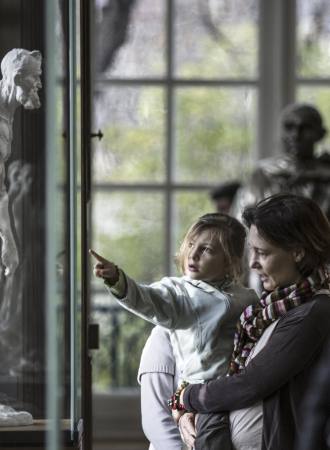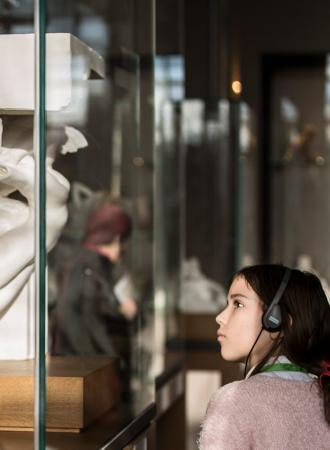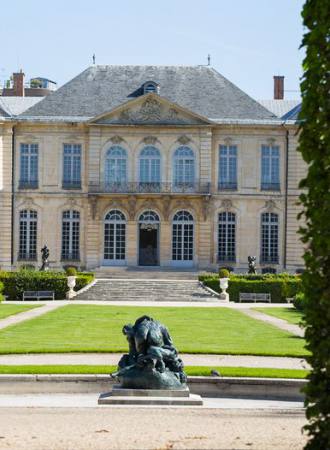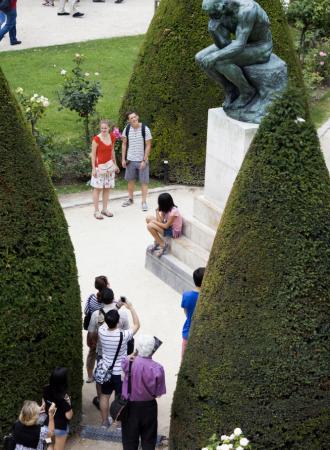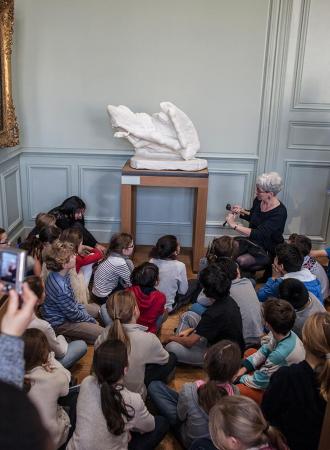Search the site


1840 – 1879
The Long Beginnings
Rejected three times from the École des Beaux-Arts, Rodin made a living through decorative and ornamental work while pursuing his personal projects independently.
1840 EN
irth of Auguste Rodin on November 12 in Paris to a modest family.
1854-1857 EN
Studies at the Imperial School of Special Drawing and Mathematics. After winning a first prize in drawing, Rodin attempted to enter the École des Beaux-Arts but failed the entrance exam three times.
Anonyme, Rodin travaillant au buste du Père Eymard, 1863
Charles Hippolyte Aubry, Portrait de Rodin coiffé d'un haute-forme, vers 1862Hippolyte Aubry, Retrato de Rodin con sombrero de copa, hacia 1862
Auguste Rodin, Académie d'homme, entre 1854 et 1857 Rodin, Académie d'homme, entre 1854 y 1857
"My passion was immense. I studied all the time... Those who saw my sculptures spoke ill of them."
1863–1865
Rodin's first known terracotta piece, Bust of a Young Girl with Roses in Her Hair, was created during this period.
Auguste Rodin, Buste de jeune fille aux roses dans les cheveux, 18601863-1865
1864 EN
Rodin began working in the studio of sculptor Carrier-Belleuse as an ornamentalist.
1864
Met Rose Beuret, who would become his lifelong companion.
Anonyme, Rodin en tenue d’atelier, 1880, Rodin vestido de taller, 1880
A. Graffe, Portrait de Rose Beuret, 1880
1871
Rodin moved to Brussels, where he worked until 1877.
1875
The Man with the Broken Nose was the first work accepted at the Paris Salon.
Auguste Rodin, L'Homme au nez cassé, modèle, 1863-65, marbre taillé en 1874-1875Rodin, Hombre con la nariz rota, modelo, 1863-65, mármol esculpido en 1874-1875
1876
Study trip to Italy, where Rodin was profoundly influenced by Michelangelo's work.
1877
Exhibited first in Brussels and then in Paris, The Age of Bronze was controversially accused of being cast directly from a live model. The scandal ultimately brought Rodin widespread attention.
Gaudenzio Marconi, Auguste Neyt, modèle de L'Âge d'airain (détail), 1877Marconi, Auguste Neyt, modelo de La Edad de Bronce (detalle), 1877
Auguste Rodin, L’Âge d’aAirain, 1877Rodin, La Edad de Bronce, 1877
1880 – 1898
Early Successes
In 1880, the French state purchased The Age of Bronze and commissioned Rodin to create The Gates of Hell for a planned Museum of Decorative Arts. This marked the beginning of his independence and access to a personal studio.
"I want to convey passion because, above all, the work must be alive."
1882
Rodin gave lessons to Camille Claudel and her fellow students at his studio on Rue Notre-Dame des Champs. Claudel joined Rodin's studio two years later as a practitioner, beginning an artistic collaboration and a tumultuous romantic relationship.
César de Séegner, Retrato de Camille Claudel, 1884
1885
The city of Calais commissioned The Burghers of Calais, inaugurated in 1895.
1888
Commande par l'État du Baiser en marbre pour l’Exposition universelle de 1889
Le Baiser (marbre) dans l'atelier du Dépôt des marbres, 1898
1891
Commissioned to create Standing Victor Hugo for the Panthéon and the first draft of the Monument to Victor Hugo for the Luxembourg Gardens.
1891
Commissioned by the Society of Men of Letters to create the Monument to Honoré de Balzac, which was ultimately rejected in 1898.
Monument à Balzac (plâtre) au Salon de la Société nationale des Beaux-Arts, 30 mai 1902 a Balzac (escayola) en el Salón de la Sociedad Nacional de Bellas Artes, 30 de mayo de 1902
Salon de la Société Nationale des Beaux-Arts, 30 mai 1898 où a été exposé le Monument à Balzac v
1892
Camille Claudel ended her relationship and artistic collaboration with Rodin.
1893
The Villa des Brillants in Meudon became the residence of Auguste Rodin and Rose Beuret.
Anonyme, La Villa des Brillants et le pavillon de l'Alma à Meudon, après 1908
1899-1915
The Glorious Years
In 1900, Rodin organized a retrospective exhibition alongside the Universal Exposition. The plaster of The Gates of Hell was unveiled to the public. By this time, Rodin was recognized as a master of French art, with his works sought after by dealers and collectors worldwide.
Maurice Alexandre Bauche, Rodin dans l'exposition du Pavillon de l'Alma, 24 février 1901 Alexandre Bauche, Rodin dans l'exposition du Pavillon de l'Alma, 24 février 1901
Jean Limet, La Porte de l’Enfer en montage à l’exposition du pavillon de l’Alma, 1900
1899
First solo exhibition in Brussels, followed by exhibitions in various Dutch cities.
1904
The large bronze version of The Thinker was publicly exhibited for the first time in London.
1906
The Thinker, donated through a subscription to the state, was placed in front of the Panthéon in Paris.
“Inauguration du Penseur de Rodin” devant le Panthéon, Discours, Le Musée : Revue d'art antique, avril 1906
"You should, dear great friend, see this beautiful building and the room I have occupied since this morning. Its three windows open magnificently onto an abandoned garden, where one can occasionally see naïve rabbits hopping through the latticework like in an old tapestry."
1908
Rodin discovered the Hôtel Biron (now the Musée Rodin) through poet Rainer Maria Rilke, his personal secretary at the time.
1911
The Burghers of Calais was purchased by the National Trust for Westminster Gardens in London.
1912
A gallery dedicated to Rodin was inaugurated at the Metropolitan Museum of Art in New York. Exhibitions of his works were also held in Saint Petersburg and Tokyo.
1916
Rodin After Rodin
By bequeathing his property and copyrights to the French state, Auguste Rodin ensured his legacy: his works would live on, accessible to all at the Musée Rodin and in international collections.
1916
Rodin donated his works to the French state to establish a museum at the Hôtel Biron in Paris.
Étienne Clémentel Rodin sur les marches de l’Hôtel Biron, 1915de su obra al Estado para fundar su museo en el Hôtel Biron de París.
Claude Harris, La Méditation, Puvis de Chavannes et un Esculape antique drapé au rez-de-chaussée, dans le vestibule, 1913
1917
On January 29, Rodin married Rose Beuret, who passed away on February 14. Rodin himself died on November 17 of the same year. They were buried together in Meudon.
Pierre CHOUMOFF Choumoff, Discours de Séverine lors des obsèques de Rodin, 24 novembre 1917
1919
The Musée Rodin in Paris opened to the public.
Albert Harlingue, l’Hôtel Biron, 1919Harlingue, el Hôtel Biron, 1919.
[Anonyme] L’Hôtel Biron, côté jardin, après 1919
1920
Kojiro Matsukata commissioned a series of Rodin bronzes, now housed in the National Museum of Western Art, Tokyo.
1924
The California Palace of the Legion of Honor in San Francisco opened, featuring the Alma Spreckels collection of Rodin sculptures.
Image courtesy of the Fine Arts Museums of San Francisco
1929
The Rodin Museum in Philadelphia, based on the collection of Jules and Etta Mastbaum, was inaugurated.
Image courtesy of the Philadelphia Museum of Art
Image courtesy of the Philadelphia Museum of Art
1939
Inauguration of the bronze Balzac at the Vavin intersection in Paris.
1960
B. Gerald Cantor began collecting Rodin’s works in the United States. His foundation later donated pieces to institutions such as the Metropolitan Museum of Art, Stanford University, the Los Angeles County Museum of Art, and others.
B. Gerald et Iris Cantor devant la Main de Dieu, ICsmthinker
1986
The Musée d’Orsay opened in Paris, with the Musée Rodin lending significant works, including the plaster model of The Gates of Hell.
1993
The Thinker was exhibited for the first time at the Meishuguan Museum Plaza in Beijing.
Meishuguan
1994
The Rodin Wing of the Shizuoka Prefectural Museum in Japan was inaugurated.
Le Penseur, Musée préfectoral, Shizuoka, Japon
2014
The Louvre Abu Dhabi acquired The Walking Man on Column.
L’Homme qui marche sur colonne, Louvre Abu Dhabi, Emirats arabes unis
2015
A cast of The Gates of Hell was created for the Soumaya Museum in Mexico City.
La Porte de l’Enfer, Museo Soumaya, Fundacióon Carlos Slim, Mexico, Mexique
